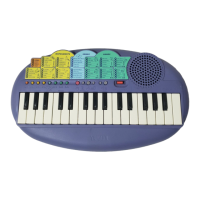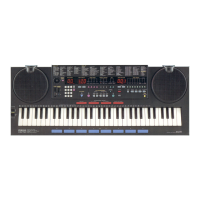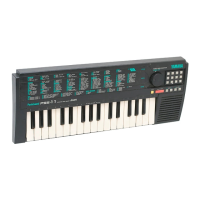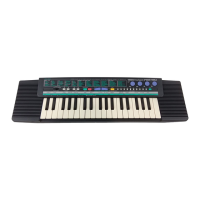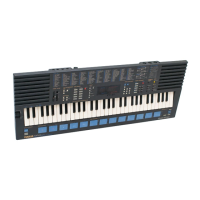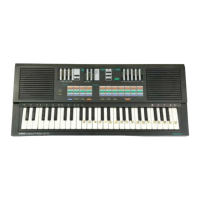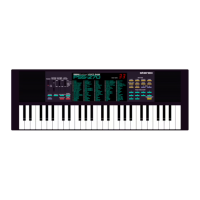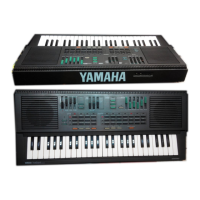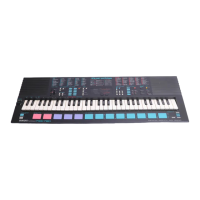
Do you have a question about the Yamaha PortaSound PSS-780 and is the answer not in the manual?
| Type | Portable Keyboard |
|---|---|
| Voices | 100 |
| Rhythms | 100 |
| Effects | Reverb, Chorus |
| Display | LCD |
| Power | Batteries |
| Connections | Headphones |
Explains the structure and purpose of the manual to help users understand the keyboard's features.
Explains how to power the PortaSound PSS-780 using batteries or an AC adaptor for operation.
Covers the fundamental steps to turn on the instrument and begin playing melodies.
Introduces the built-in demonstration song to showcase the PortaSound's capabilities.
Outlines the extensive musical capabilities and features offered by the PortaSound PSS-780.
Explains how the Voice/Melody, Rhythm, and Auto Accompaniment sections work together to create music.
Details how to select and use the 100 preset FM voices, including effects and pitch manipulation.
Describes how rhythm and auto-accompaniment features enhance performances with patterns, chords, and orchestration.
Guides users on how to choose and input numbers for the 100 preset FM instrument sounds.
Explains how to play along with the built-in demonstration song using selected instrument voices.
Introduces six built-in effects like Vibrato, Sustain, and Reverb to enhance instrument tones.
Explains the Portamento effect for smooth pitch gliding between notes and its adjustable speed.
Describes the Stereo Chorus effect for creating a wide, spatial stereo sound impression.
Details the Duet feature that adds a harmonizing second voice to your melody playing.
Explains how to use the pitch bend wheel to alter note pitch and adjust its range for expressive playing.
Covers how to adjust parameters like Transpose, Tuning, and Melody Volume using the dedicated controls.
Explains how to change the overall pitch of the keyboard to different keys for easier playing.
Details how to adjust the instrument's overall pitch to match other instruments.
Describes how to adjust the volume balance between the melody and auto-accompaniment parts.
Introduces the PortaSound's rhythm machine capabilities for creating drum patterns and keeping time.
Guides users on selecting one of the 100 built-in rhythm styles to accompany their music.
Explains how to start, stop, and vary rhythms using dedicated pads for live control.
Details how to adjust the speed (tempo) of rhythms and auto-accompaniments.
Explains the function of the beat indicators for timing and synchronization information.
Describes how to switch rhythm styles while a song is playing without interruption.
Explains how to use the 8 drum pads to play custom rhythms or record patterns with different drum sets.
Guides on creating and recording unique drum patterns from scratch or modifying existing ones.
Details how to activate and play custom drum patterns created with the Custom Drummer function.
Introduces the various automatic accompaniment modes like Single Finger and Fingered.
Explains the Normal, Single Finger, and Fingered modes for controlling auto-accompaniment.
Describes how to select and control the instruments (bass, rhythm, chords, orchestra) used in the auto-accompaniment.
Explains how to play complete chords using a single finger in the Auto Accompaniment section.
Guides on creating full accompaniments with bass, chords, and orchestra using single finger chords.
Explains how accompaniment patterns adapt to chord changes for a natural musical effect.
Details the methods for stopping the auto-accompaniment playback.
Explains how to adjust tempo and switch styles during auto-accompaniment playback.
Describes how to play complex chords using multiple fingers for more advanced auto-accompaniment.
Explains the Duet feature for automatically adding a harmonizing second voice to melodies.
Introduces the feature for recording and playing back melodies and chord progressions.
Details how to record and store melodies, including voice and effect settings.
Explains how to play back recorded melodies, with or without rhythm accompaniment.
Guides on recording new melodies while simultaneously playing back existing ones.
Explains how to record and play back chord progressions and accompaniment patterns.
Details how to play back recorded chord progressions and accompaniment data.
Introduces the FM synthesis engine, allowing users to create and save custom instrument sounds.
Provides a foundational understanding of FM synthesis principles for sound creation.
Explains how to adjust the nine voice parameters to edit and create unique FM sounds.
Offers a basic explanation of FM synthesis concepts like modulation and envelopes.
Details how attack rate parameters affect the initial volume and tonal quality of synthesized sounds.
Explains how decay rate parameters influence the fading of synthesized sound over time.
Covers how frequency parameters determine pitch and harmonic structures in synthesized sounds.
Explains the feedback level parameter for self-modulation, affecting sound brightness and sharpness.
Details how the total level parameter controls the overall volume of synthesized voices.
Summarizes the function and range of each parameter used in the digital synthesizer section.
Defines MIDI as a communication standard for electronic musical instruments and devices.
Details the MIDI port connections and their functions for data transmission and reception.
Explains the two MIDI modes: Keyboard Assign and Sound Source, for controlling external MIDI gear or using the PSS-780 as a sound module.
Describes how to use the PSS-780 keyboard to control external MIDI instruments.
Lists the types of MIDI data transmitted in Keyboard Assign mode, including notes and program changes.
Explains how program change data controls voice and style selection via MIDI.
Details how control change data transmits effects like vibrato, sustain, and portamento.
Guides on selecting the MIDI channel for transmitting data from the PSS-780.
Explains how pitch bend data is transmitted for expressive control.
Details how to transfer all stored data (synthesizer, song, drum patterns) to external devices.
Explains how to use the PSS-780 as a multi-timbral sound module controlled by external MIDI devices.
Lists MIDI data transmitted when the PSS-780 acts as a sound source.
Explains how to select MIDI channels for receiving data and control external clock sources.
Explains the procedure to reset all internal settings and data to their factory defaults.
Lists Yamaha Standard Voice numbers and their corresponding MIDI program change values.
Outlines the MIDI implementation for Mode 00 (Keyboard Assign mode), specifying transmitted and recognized data.
Outlines the MIDI implementation for Mode 99 (Sound Source mode), specifying transmitted and recognized data.
